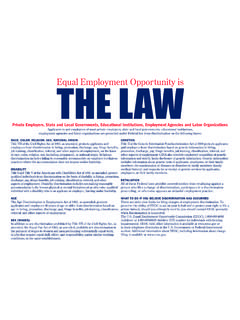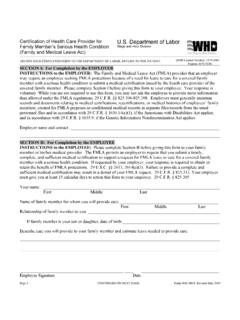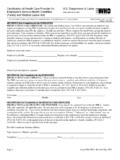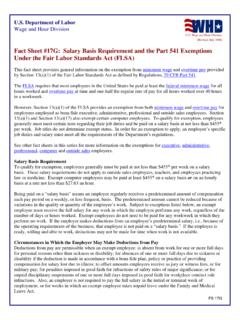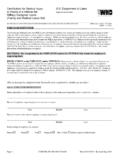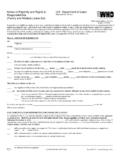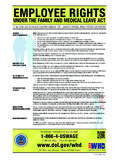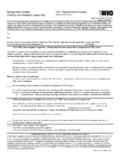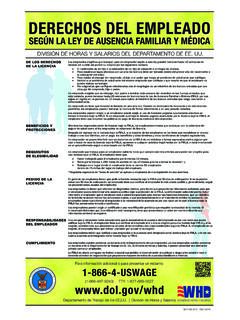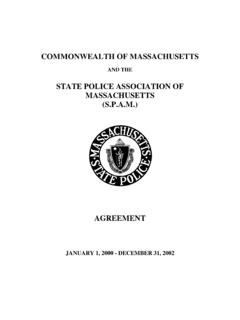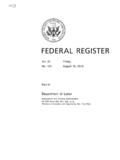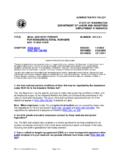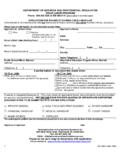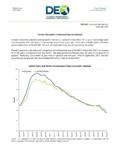Transcription of A Non-Technical Resource Guide to the Uniformed Services ...
1 A Non-Technical Resource Guide to the Uniformed Services employment and Reemployment Rights Act (USERRA) The department of labor Veterans employment and Training Service March 2003 Introduction The department of labor s Veterans employment and Training Service provides this Guide to enhance the public s access to information about the application of the Uniformed Services employment and Reemployment Rights Act (USERRA) in various circumstances. Aspects of the law may change over time. Every effort will be made to keep the information provided up-to-date. USERRA applies to virtually all employers, including the Federal Government.
2 While the information presented herein applies primarily to private employers, there are parallel provisions in the statute that apply to Federal employers. Specific questions should be addressed to the State director of the Veterans employment and Training Service listed in the government section of the telephone directory under department of labor . Information about USERRA is also available on the Internet. An interactive system, The USERRA Advisor, answers many of the most-often asked questions about the law. It can be found in the E-Laws section of the department of labor s home page.
3 The Internet address is Disclaimer This user s Guide is intended to be a Non-Technical Resource for informational purposes only. Its contents are not legally binding nor should it be considered as a substitute for the language of the actual statute. Table of Contents Who s eligible for reemployment?.. 2 Advance 2 Duration of 3 Exceptions .. 3 Reporting back to 5 Documentation upon return (Section 4312(f)).. 6 Unavailable documentation .. 6 How to place eligible persons in a 6 Escalator" position .. 7 Prompt" 8 Disabilities incurred or aggravated while in Military 8 Conflicting reemployment 8 Changed 9 Undue 9 Rights of reemployed 9 Seniority rights Section 4316(a).
4 9 Pension/retirement plans .. 10 Vacation pay .. 11 Health benefits .. 11 Protection from discharge .. 12 Protection from discrimination and 12 13 Veterans employment and Training 13 Government-assisted court 13 Private court 14 Service Member 15 Employer 15 employment and Reemployment Rights The Uniformed Services employment and Reemployment Rights Act of 1994 (USERRA), enacted October 13, 1994 (Title 38 Code, Chapter 43, Sections 4301-4333, Public Law 103-353), significantly strengthens and expands the employment and reemployment rights of all Uniformed service members.
5 2 Who s eligible for reemployment? Service in the Uniformed Services and Uniformed Services defined -- (38 Section 4303 (13 & 16) Reemployment rights extend to persons who have been absent from a position of employment because of "service in the Uniformed Services ." "Service in the Uniformed Services " means the performance of duty on a voluntary or involuntary basis in a Uniformed service, including: Active duty Active duty for training Initial active duty for training Inactive duty training Full-time National Guard duty. Absence from work for an examination to determine a person s fitness for any of the above types of duty.)
6 Funeral honors duty performed by National Guard or reserve members. Duty performed by intermittent disaster response personnel for the Public Health Service, and approved training to prepare for such service (added by Pub. L. 107-188, June 2002). See Title 42, Code, section 300hh-11(e). The " Uniformed Services " consist of the following: Army, Navy, Marine Corps, Air Force, or Coast Guard. Army Reserve, Naval Reserve, Marine Corps Reserve, Air Force Reserve, or Coast Guard Reserve. Army National Guard or Air National Guard. Commissioned Corps of the Public Health Service. Any other category of persons designated by the President in time of war or emergency.
7 "Brief Nonrecurrent" positions (Section 4312(d)(1)(C)) The new law provides an exemption for preservice positions that are "brief or nonrecurrent and that cannot reasonably be expected to continue indefinitely or for a significant period." Advance Notice (Section 4312(a)(1)) The law requires all employees to provide their employers with 3advance notice of military service. Notice may be either written or oral. It may be provided by the employee or by an appropriate officer of the branch of the military in which the employee will be serving. However, no notice is required if: military necessity prevents the giving of notice; or the giving of notice is otherwise impossible or unreasonable.
8 "Military necessity" for purposes of the notice exemption is to be defined in regulations of the Secretary of Defense. These regulations will be immune from court review. Duration of Service (Section 4312(c)) The cumulative length service that causes a person s absences from a position may not exceed five years. Most types of service will be cumulatively counted in the computation of the five-year period. Exceptions . Eight categories of service are exempt from the five-year limitation. These include: (1) Service required beyond five years to complete an initial period of obligated service (Section 4312 (c)(1)).
9 Some military specialties, such as the Navy s nuclear power program, require initial active service obligations beyond five years. (2) Service from which a person, through no fault of the person, is unable to obtain a release within the five year limit (Section 4312(c)(2)). For example, the five-year limit will not be applied to members of the Navy or Marine Corps whose obligated service dates expire while they are at sea. Nor will it be applied when service members are involuntarily retained on active duty beyond the expiration of their obligated service date. This was the experience of some persons who served in Operations Desert Shield and Storm.
10 (3) Required training for reservists and National Guard members (Section 4312(c)(3)). The two-week annual training sessions and monthly weekend drills mandated by statute for reservists and National Guard members are exempt from the five-year limitation. Also excluded are additional training requirements certified in writing by the Secretary of the service concerned to be necessary for individual professional development. (4) Service under an involuntary order to, or to be retained on, active duty during domestic emergency or national security related situations (Section 4312(c)(4)(A)). 4 (5) Service under an order to, or to remain on, active duty (other than for training) because of a war or national emergency declared by the President or Congress (Section 4312(c)(4)(B)).
